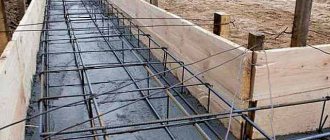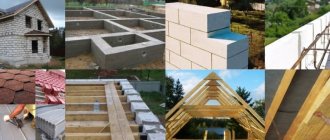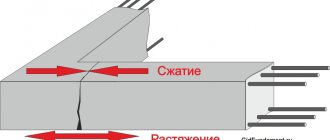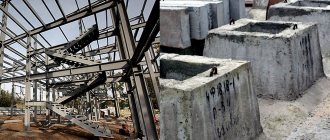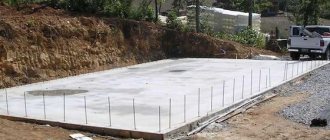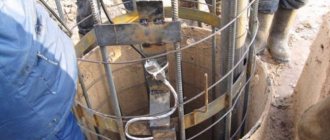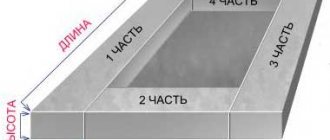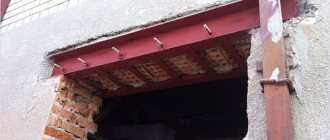"Ooo! Have you also studied foundation reinforcement?” – we heard such questions decorated with surprised eyes from our neighbors at this stage. But we know for sure that if you don’t know how to do something, it doesn’t mean that you can’t learn it. Even when it comes to reinforcing the foundation slab.
We are building a house with our own hands, so we are responsible not only for construction, but also for design, studying standards and the experience of self-builders, calculating the necessary materials, purchasing and much more. In this article, we share what we learned about the rules for reinforcing a foundation slab, and also talk about the adventures associated with this stage.
Why is it necessary to reinforce a slab foundation?
The foundation of a house must withstand different types of loads: compression and tension. We will talk about the first type of load in the article about pouring the foundation with concrete. But whether the slab will withstand bending and tensile loads or not depends on how competently the reinforcement stage was carried out.
A foundation slab without reinforcement is possible, but still this design option is not for a heavy permanent residential building. If you build some kind of outbuilding on non-heaving soils, you can think about saving on reinforcement. But for the construction of a residential building, this is, of course, not serious. As mentioned above, the foundation may not withstand tensile and bending loads.
For clarity, I’ll give you an example: you have a monolithic foundation slab poured for a house. When you put up the walls and roof, the pressure on the slab will be exerted to a greater extent on the contour of the foundation just under the walls, and not across the entire area. Thus, the walls will tend to break off the concrete, especially if the preparation of the base and the cushion under the foundation are done poorly. And if you also take into account the force of frost heaving, then the pressure on the slab will increase. The walls will push the foundation down, and the heaving soil will press into weak, unloaded areas. Which, as a result, can lead to a fracture of the foundation. So, in order to eliminate such moments, you need to approach the issue of reinforcement competently.
Monolith formation technology
The set of measures for constructing a monolithic base includes the following steps:
- marking and cleaning the site;
- extraction of earth for a foundation pit of the required size;
- formation of a drainage system;
- backfilling and compaction of the sand and gravel base;
- performing waterproofing;
- assembly and fixation of formwork;
- installation of reinforcement cage and foundation reinforcement;
- concreting.
The reliability of a monolithic base is determined not only by the quality of the concrete solution, but also by correctly performed reinforcement. Let's look at this operation in more detail.
What kind of fittings are there?
For different types of foundations with different degrees of load, the required type of reinforcement is used. Let's figure out what materials the reinforcement can be made of. Next there will be a lot of SNiPs, numbers and technical designations, but don’t be alarmed. Just accept that all this data is necessary if you want your building to have a long life.
Steel reinforcement
Made from carbon (consists of iron and carbon, alloying elements are present in very small quantities) and low-alloy steel (an alloy of iron and alloying elements such as nickel, copper, titanium, vanadium, etc. Contains up to 0.25% alloying elements ). Low alloy steel has better mechanical characteristics and is more resistant to corrosion.
According to the type of production, fittings are:
- Cold rolled. It is produced by the cold method, which requires more ductile steel. In the class division it is marked B.
- Hot rolled steel. It is processed at high temperatures and welds perfectly. Marked with the letter A. Most often used in private housing construction.
- Rope steel. It is marked with the letter K. This is a twisted reinforcing rope, consisting of a group of wires. The most commonly used rope is a seven-wire rope. Excellent adhesion to concrete.
According to the type of surface, the reinforcement is divided:
- Smooth. Not suitable for building foundations, as due to the smooth surface it adheres less well to concrete. Can be used for floor screeding or for building walls.
- Ribbed reinforcement with ring profile. Adheses well to concrete, but gradually loses its adhesive strength with repeated loading.
- Ribbed reinforcement with crescent profile. It adheres worse to concrete than to a ring profile. But due to the peculiarity of the profile, the endurance of the structure is higher, since the susceptibility to periodically repeated loads is better.
- Ribbed reinforcement with a combined profile. The profile is designed for A500SP fittings.
Types of reinforcement
Strength classes of reinforcement:
Outdated fittings class markings according to GOST 5781-82: A-I, A-II, A-III, A-IV, A-V, A-VI.
Modern designations of fittings class: A240, A300, A400, A500, A600, A800, A1000.
- The letter A at the beginning of the marking indicates rod reinforcement
- The marking with the letter B at the beginning means that it is a wire
- The letter K at the beginning means that this is a rope reinforcement
- Marking with the letters At at the beginning means thermally strengthened reinforcement. Such fittings have increased strength and resistance to corrosion.
- The letter K after the numbers means that the reinforcement is resistant to corrosion
- The letter C at the end after the numbers indicates that this reinforcement can be welded
Reinforcement strength classes
More detailed markings can be found in GOST 34028-2016 Reinforcing bars for reinforced concrete structures.
Composite polymer reinforcement (ARP)
Types of automatic transmission:
- glass composite (ASC);
- basalt composite (ABK);
- carbon composite (AUK);
- aramidocomposite (AAK);
- combined (ACC)
The type of automatic transmission should be selected taking into account the operating conditions of the structure, the nature of their loading and economic indicators. You can study in more detail Amendment No. 1 to SNiP 52-01-2003 Concrete and reinforced concrete structures.
The automatic transmission is made from plastics. Costs more than steel reinforcement. One of the advantages of the composite is that it does not conduct current, weighs significantly less, and is absolutely not afraid of corrosion. It is still rarely used in private housing construction. But are these advantages so important in private housing construction?
The video compares composite reinforcement with steel
Materials
Reinforcement is the strengthening of a concrete block from the inside using various materials. Rods or fibers can be used that, when the block is stretched, do not allow it to crack.
In practice, reinforcement materials can be divided into 3 groups:
- metal rods,
- composite reinforcement,
- fiber.
Steel bars
The standard length of a steel bar for reinforcing concrete structures is 11.75 m. The reinforcement can have different diameters and grades. Depending on the marking, the rods are joined into a reinforcing frame by welding or knitted with wire.
In the mass of concrete, the connection between the steel rods and the mortar is quite strong due to the corrugation on the rod. The steel frame inside the monolith redistributes the loads and keeps the concrete from cracking, since the metal has greater tensile strength. At the same time, concrete, in turn, protects the metal from corrosion.
Steel reinforcing frameComposite material
Such fittings have a fairly wide range of source materials, increasing almost every year. To date, fiberglass and basalt plastic rods with spiral wrapping, simulating the periodicity of the steel reinforcement profile, are more or less used.
In addition, the construction market offers polyethylene rephthalate and hydrocarbon fittings, which have not yet received widespread popularity. The undeniable advantage of the composite is its low weight. But when constructing foundations or retaining walls, this advantage is of little importance, but the strength characteristics are very important.
Composite reinforcement is usually used in horizontal building elements supported on the ground
Fiber fiber
Fine material (fiber) is added to the solution at the mixing stage. Moreover, the fiber itself can have different diameters and lengths.
Fiber is made from fiber based on:
- become,
- glass,
- polypropylene compounds,
- basalt.
Fiber fiber to enhance the tensile strength of concrete
What reinforcement should I use for the foundation slab?
The most commonly used diameters of longitudinal working reinforcement in private buildings are 10, 12, 14 and 16 mm. 6 and 8 mm are used as transverse reinforcement. For reinforcement of foundations, reinforcement of class A400 - A500C is mainly used. For reinforcement of class A400, the yield strength is 390 N/mm2, and for class A500C it is over 500 N/mm2. Another important difference is that A400 cannot be joined by welding, in which case the structure of the steel is weakened. For these reasons, class A500C fittings are most often used. For foundations, reinforcement with a crescent profile is best suited because it has higher resistance to periodic loads, despite worse adhesion to concrete compared to a ring profile.
Characteristics of the reinforcement series
In order to understand which reinforcement is best suited, you need to decide on the type of foundation and calculate the loads on it.
Thickness of a slab foundation: Example of how to calculate the thickness of a slab
We make coasters
The bottom layer of the reinforcing frame is laid on ready-made plastic stands, after which special “tables” are installed on it, which support the next layer of the structure. They are made from a piece of reinforcement, the size of which is calculated based on the thickness of the monolithic slab. Let's say we are dealing with a base 40 cm thick. In this case, the calculations will be as follows:
40 cm (height of the slab) – 8 (two protective layers of 4 cm each) – (4 x 1 cm) (thickness of the rods multiplied by their number) = 28 cm.
A supporting “table” is made by bending it into a U-shape. The bending radius is selected individually. The “tails” of the stand are bent in opposite directions, thereby forming reliable stops that will allow you to lay and fix both layers of the structure.
Foundation slab reinforcement diagram
The reinforcement scheme for a slab foundation is selected based on the following characteristics:
Foundation thickness. For a foundation slab with a thickness of 15 centimeters or less, reinforcement is performed with one mesh consisting of longitudinal and transverse reinforcement. For greater thickness, the reinforcement of the foundation slab is performed in two layers. When reinforcing, you need to remember about the protective layer of concrete for the reinforcement; it protects the reinforcement from corrosion. According to clause 10.3.2 and table 10.1 SP 63.13330.2018, the thickness of the protective layer of concrete should be:
– In the open air without additional protective measures, at least 3 cm
– In the ground without additional protective measures, in monolithic foundations with concrete preparation of at least 4 cm
– In monolithic foundations without concrete preparation (only for lower working reinforcement) at least 7 cm. The concrete preparation can also be a crushed stone cushion, since it is not a capillary conductor of moisture, provided that drainage is done and the cushion is not standing in water.
Cushion under the foundation slab: Geotextile, footing, crushed stone
Foundation load. It is necessary to calculate the total weight of the house, snow and wind loads in your region. And also determine in which places greater pressure will be exerted on the foundation (load-bearing walls, columns).
Bearing capacity of the soil. It is necessary to carry out geology, determine the type of soil and, using a table from SNiP, find out the bearing capacity of the soil.
Diameter of fittings. If the side of the foundation slab is 3 meters or less, then use reinforcement of 10 mm. If the length exceeds 3 meters, then reinforcement with a diameter of 12 mm and above is used.
Pitch of rods. In accordance with clause 10.3.8 - 10.3.10 SP 63.13330.2018, the reinforcement spacing in a monolithic foundation slab is 20-40 centimeters. No more than 20 cm with a cross-sectional height of up to 150 mm. No more than 40 cm with a cross-sectional height of more than 150 mm. The maximum distance between reinforcement bars should not exceed the thickness of the foundation by more than one and a half times. In places where heavy loads are placed on the foundation (load-bearing walls and columns), the size of the reinforcement cell for a slab foundation is reduced by 2 times.
Methods for making meshes and frames
The meshes are manufactured in accordance with GOST 23279-2012. There are only two options for connecting rods to each other: knitting and welding.
The first uses a thin wire with a diameter of 2-3 mm, which is wound around the rods manually or using special devices. This option is quite labor-intensive, but provides greater reliability of the connections, since it allows the rods to adapt to small movements of the structure.
Vertical clamps can be made as in the photo below:
Spider made of reinforcement with a diameter of 8-10 mm.
Ready-made welded mesh will ensure high speed of work. But the number of standard sizes is limited, and it is not always possible to choose the one you need. If the decision is made to use welding directly on the construction site, in particularly critical places (corners of the building, areas supporting massive walls), the reinforcement is connected with wire.
The template will help when tying reinforcement.
Percentage of foundation slab reinforcement
For concrete to become reinforced concrete, it is not enough just to lay reinforcement. There is such a concept - the minimum cross-sectional area of longitudinal reinforcement in reinforced concrete elements. If the percentage of reinforcement is below the minimum, then the transition from concrete to reinforced concrete will not occur, the concrete will still remain concrete. Magic? No. It’s just that in order for the reinforcement to play its role, there must be a sufficient amount of it. SNiP 2.03.01-84 clause 5.16 states that the minimum percentage of reinforcement for the foundation slab is:
- 0.05% of the cross-sectional area of concrete. Reinforcement S in bending and also in eccentrically tensioned elements when the axial force is located outside the working height of the section
- 0.05% of the cross-sectional area of concrete. Reinforcement S, S” in eccentrically tensioned elements when the longitudinal force is located between reinforcement S and S”
- From 0.1 to 0.25%. Reinforcement S, S” in eccentrically compressed elements
- In elements with longitudinal reinforcement distributed evenly along the contour of the section, as well as in centrally stretched elements, the minimum cross-sectional area of all longitudinal reinforcement should be taken to be twice the values indicated above.
You can't spoil the porridge with oil, but you can ruin the foundation with reinforcement. Therefore, there is a maximum percentage of reinforcement. Exceeding the standards will worsen the technical characteristics of reinforced concrete. The maximum percentage of reinforcement for columns is 5%, and in all other cases 4%. It must be taken into account that the concrete mixture must penetrate freely between the reinforcement.
Errors when installing reinforcing structures
Even minor defects can lead to the destruction of the foundation or complicate the concreting process. Common mistakes when creating a frame and how to avoid them:
- rods connected end-to-end will lead to loss of strength of the frame structure;
- When installing a reinforcing frame, the rods are located in close proximity to the ground or stuck into it. When the soil moves, the reinforcement will crash into the ground and with this interaction, metal corrosion will form, and this in turn will reduce the strength of the entire foundation;
Reinforcement clamp, which is installed between the meshSource buildpj.ru
failure to comply with recommendations for the location of reinforcement leads to destruction of the slab;
if the ends of the rods do not have a protective coating, corrosion of the products will form under the influence of moisture from the concrete mixture;
special attention should be paid to proper reinforcement in the corners of the building and in areas under the load-bearing wall;
the frame was installed on wooden blocks or other unsuitable elements - this is a gross mistake. You only need to use special fasteners
Otherwise, moisture will penetrate to the metal parts, which in turn will lead to a violation of the integrity of the concrete base.
Calculation of foundation slab reinforcement
The standard for rebar cutting is 6 and 11.7 meters. For example, we can calculate the reinforcement for a foundation slab measuring 6*6 meters. Let's take a slab 15 centimeters thick for a light one-story country house made of hollow cinder block. Since the slab is 15 centimeters, the reinforcing mesh will accordingly be in one row, consisting of longitudinal and transverse reinforcement. None of the sides of the slab is less than 3 meters, respectively, the thickness of the reinforcement for the slab foundation in this case will be 12 mm in diameter. The reinforcement pitch will be 20 cm, because the slab is 15 centimeters, let’s take it with a margin, although the pitch could be increased. The house is small, so there will be only 4 load-bearing walls in the house, the internal partitions will be light and will not require additional reinforcement of the foundation underneath them.
So, let's count. The length and width of the slab are 600 centimeters. To calculate how many reinforcement rods are needed for longitudinal reinforcement, you need to divide the slab length of 600 centimeters by the reinforcement pitch of 20 centimeters.
It turns out, 30 rods + 1 last rod + 2 rods for reinforcement under load-bearing walls, the step there will be 10 centimeters, a total of 33 rods.
Transverse reinforcement of the foundation slab is calculated similarly to longitudinal reinforcement, since the values are the same. It turns out that to reinforce this slab we will need 66 reinforcement rods.
Monolithic foundation slab reinforcement diagram
How much rod do you need?
Having developed a strip foundation reinforcement scheme, you know how many longitudinal elements you need. They are laid around the entire perimeter and under the walls. The length of the tape will be the length of one reinforcement rod. By multiplying it by the number of threads, you get the required length of the working reinforcement. Then add 20% to the resulting figure - a margin for joints and overlaps. This is how much in meters you will need working reinforcement.
You count how many longitudinal threads according to the diagram, then calculate how many structural rods are needed
Now you need to calculate the amount of structural reinforcement. Calculate how many crossbars there should be: divide the length of the tape by the installation pitch (300 mm or 0.3 m, if you follow the recommendations of SNiP). Then you calculate how much it takes to make one lintel (add the width of the reinforcement cage with the height and double it). Multiply the resulting figure by the number of jumpers. You also add 20% to the result (for connections). This will be the amount of structural reinforcement to reinforce the strip foundation.
Using a similar principle, you calculate the amount needed to reinforce the sole. Putting everything together, you will find out how much reinforcement is needed for the foundation.
Do-it-yourself reinforcement of a monolithic foundation slab
Initially, we designed a house measuring 6 by 6 meters with an attic floor. In this case, everything would be simpler with reinforcement: a mesh of six-meter rods, with reinforcement around the perimeter, under the walls. They wanted to make the second floor a gable roof and cover the gables with wood. But, having estimated how much lumber it will take for all this (in Georgia, timber costs twice as much as in Russia), imagining how we will cover such a roof together, how much timber will need to be hauled up, calculating how much space the stairs to the second floor will take up floor, we decided to replay it before it was too late. It’s good, at least this idea came to mind at the stage of digging a pit.
Foundation slab pros and cons: marking, excavation
The updated project was completed in one day, and additional blocks were ordered before the factory had time to bake the first batch and send it to us. We decided to build a house 6 by 8 meters, also with a gable roof, only with a slight slope, only half a meter. The small slope is due to our southern climate and sparse snow with little cover. The project added a fifth load-bearing wall, on which the ridge girder will rest.
Calculation of reinforcement for a foundation slab, personal experience
Since our house is relatively not heavy, not large in size, the load-bearing capacity of the soil is good, we carried out good crushed stone preparation for the house, drained the foundation, designed an additional load-bearing wall in the middle (which makes the load more uniform) and after calculating all the loads, it was decided not to pour excess concrete and, accordingly, do not hide expensive rolled metal there.
In our case, a slab of 15 centimeters was more than enough, and therefore one row of reinforcing mesh (remember the theory above).
Next, we determine the diameter of the reinforcement. Taking into account the dimensions of the slab and the load on the foundation from the walls and soil, relying on the positive experience of self-builders and standards, we conclude that reinforcement with a diameter of 12 mm will be sufficient, both in longitudinal and transverse locations. The reinforcement spacing was taken to be 20 centimeters. Although it would have been entirely possible to increase it, we decided not to skimp on it. Under load-bearing walls, the reinforcement spacing was halved. The reinforcement was used with a length of 6 meters (for the transverse one, a rod length of 6 meters was enough, and the longitudinal one was increased). So, let's start the calculation with transverse reinforcement. The length of the building is 800 centimeters. We divide 800 cm by 20 cm (reinforcement pitch), we get 40 rods + 1 last one + 2 for reinforcement under load-bearing walls, a total of 43 rods.
Now we consider the longitudinal reinforcement. The width of the building is 600 centimeters, divide 600 cm by 20 cm, we get 30 rods + 1 last one + 3 for reinforcement under the load-bearing walls (three, because there is a load-bearing wall in the middle of the house), a total of 34 rods. But since the length of the longitudinal reinforcement should be 800 cm, it is necessary to add another half of 34 rods (1 rod is enough for 2 longitudinal sections). This means that we add 17 more rods to 34.
Total: 43 + 34 + 17 = 94 reinforcement bars 6 meters long, we threw another 16 pieces onto the reinforced belt, which we will fill after the walls are built.
Under load-bearing walls, the reinforcement spacing is 10 centimeters (over the rest of the area - 20 centimeters)
Ordering reinforcement for the foundation slab
Ordering fittings turned out to be a whole story for us. We were looking for ribbed reinforcement with a crescent profile of classes A400-A500. We found out in the regional center the price per linear meter - 2.15 lari (1 lari ~ 25 rubles), class A500. We decided to find out in larger cities, found it for 1.7 GEL, a good deal - 297 GEL (7,425 rubles), minus delivery 100 GEL (2,500 rubles), still five stick. It's decided, let's order. But not everything is so fast; in Georgia no one is in a hurry. It turns out that we have to wait for a car with a long body to appear to deliver our cargo. We've been talking to the seller for a week on the phone, but things are still there. At that point, we are already done with the crushed stone backfill, the next stage is formwork for 1-2 days and that’s it, we are faced with easy work, and we don’t like that!
A week later, after many long calls, the seller finally responded and said: “Okay, I’ll give your number to the person, he will call.” Less than five minutes later, a man calls and in pure Russian (only the word “brother” gives him away), asks what and how much is needed. Gives a verdict: 660 linear meters of A500 class fittings at 1.5 GEL per linear meter will cost: 990 + 150 GEL for delivery. I indignantly ask why 150, because a week ago it was announced 100, and I mentally rejoice that the fittings have fallen in price per meter by 20 tetri, which enriches me from an order of 132 lari (= 3,300 rubles). The person testifies that, they say, we have a pass over a mountain and it’s hard for the car to drive, it will take more gasoline. I mentally wave my hand and tell him to harness the horses and take her at a gallop as quickly as possible. At the other end of the phone there was a voice: “Now I’ll tell you the details of where to transfer the money.” To which I replied: “That won’t work, I don’t transfer money to a stranger for goods that I don’t see. Brother, first the chairs, then the money. I need this fittings, I’ve been waiting for it for a week, I won’t let you down.” The person on the other end of the phone: “...Aufff...give me the address.”
Two hours later the call rang: “I’ve arrived.” I clarified whether he really came to us, it seemed too fast. But he rushed towards the center of the village; as it turned out, he really had five kilometers left from the regional center. Having reached the center, I saw the 24th Volga driving in, and my fittings were on the roof; it turned out that a car with a long body was not so necessary! We unloaded these 600 kilograms in 10 minutes, chairs for me - money for him, everyone was happy!
Reinforcement for foundation slab

